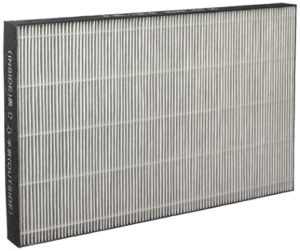Skip to content
Most coronavirus infections seem to occur at short distances, when infected persons sneeze or cough. However, many infections also seem to occur with airborne transmission, when smaller drops (aerosols) with the virus stay suspended in the air. ASHRAE provides many guidelines to help prevent the airborne transmission of coronavirus. One of the recommendations is using air filters with at least a MERV 13 rating, or the superior HEPA rating if possible. This article will briefly describe each filter rating and its applications.

The professional opinion of an HVAC engineer is strongly recommended before attempting to upgrade any air filters. More efficient filters cause a higher pressure drop, and your air handling unit may not have enough capacity. There are three main options to improve air filtering in buildings:
Upgrading to more efficient filters, while staying within the operating capacity of your ventilation system.
Upgrading to an even higher filter efficiency, but also upgrading your ventilation system to overcome the additional pressure drop.
Using portable air cleaners with high efficiency filters. These can complement HVAC filter upgrades, or they can be used as an alternative when an upgrade is not possible.
Air filters are not only a prevention measure against airborne pathogens. They also capture inorganic pollutants like particulate matter, improving your indoor air quality in general. For even better results, filtering can be combined with an air purification method, such as Ultraviolet Germicidal Irradiation (UVGI). Air purification with UVGI not only inactivates viruses, but also bacteria and mold spores.
Air filtering and other indoor air quality measures for coronavirus are intended as a complement for the guidelines provided by health authorities: social distancing, handwashing, personal protective equipment (PPE), etc. These measures cannot be overlooked, even if your building has the best air filtering and disinfection systems in the market.
The MERV of a filter is determined with laboratory tests according to ASHRAE Standard 52.2. The test uses an aerosol generator and synthetic dust specified by ASHRAE, and particle counts are measured upstream and downstream from the filter. The testing procedure for the MERV rating uses 6 measurements and 12 particle sizes, which results in a total of 72 data points.
To help prevent coronavirus infections in buildings, ASHRAE recommends upgrading air filters in HVAC systems to at least MERV 13.
In cases where this is not possible, portable air cleaners with MERV 13 or better filters can be used.
In residential settings, ASHRAE recommends upgrading typical 1-inch filters to MERV 13, and upgrading 2-inch filters to MERV 16. However, you should double-check with an HVAC engineer before proceeding.
When using UVGI for in-duct air cleaning, ASHRAE recommends using at least MERV 8 filtering to complement the disinfection system.
Our engineering firms are looking to prevent the spread of a virus like SARS-Covid-2 and many others helping in make our places safer and minimizing risks.
